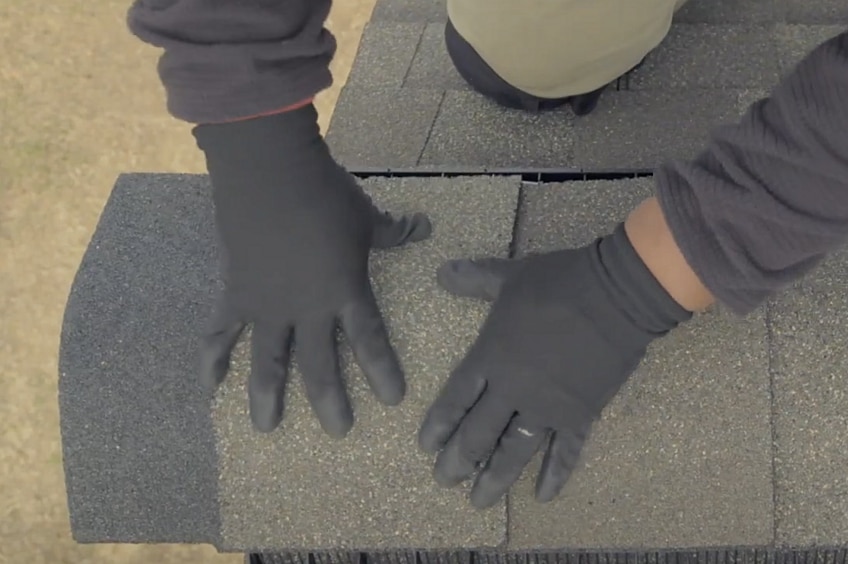One high-stress area of a residential roof is where its two faces meet, either at a hip or a ridge. Protecting these areas helps reduce the risk of leaks. Before the advent of shingles purpose-made for hip and ridge caps, roofers typically cut up 3-tab strip shingles and bent them over these areas of the roof. Today, specially made versions of these types of shingles provide better protection while maintaining a roof's aesthetic appeal.
Here's what to know about these products and the benefits they can offer.
What Are Hip and Ridge Cap Shingles?
Hip and ridge caps are specially designed asphalt shingles that protect the areas where two roof faces meet. They're typically curved or bent in the middle to help protect the joint from water intrusion and debris. These specialized shingles may look different than other roof shingles, but they're made from the same material and come in a range of designs so they can seamlessly match the color and texture of the standard shingles they are paired with.
Common Styles
Standard
Standard hip and ridge caps are made of the similar material as asphalt shingles. As a standard, cost-effective option for GAF roof systems, Seal-A-Ridge® Ridge Cap Shingles are used.
SBS-Modified
For roofs on homes in areas that experience hail, styrene-butadiene-styrene- (SBS) modified ridge caps, such as GAF Seal-A-Ridge® AS Ridge Cap Shingles are a popular option. SBS is a plastic polymer that makes the ridge cap more flexible than standard asphalt ridge caps to help absorb impact. It's important to note, however, that the these SBS-modified ridge caps are not warranted to withstand hail damage.
Wood Shake
Homes with roofs that have wood shake-style shingles need hip or ridge caps designed to imitate their roof shingles' three-dimensional look. GAF Z®Ridge Distinctive Ridge Cap Shingles have a unique folded ("Z-fold") design that helps simulate the look of traditional wood shakes but are made of asphalt.
Premium
When a home's roof uses premium shingles, it needs premium caps that will match those shingles' dimensions and/or aesthetics. GAF has three premium cap systems: TimberCrest®, and TimberTex® ridge caps that are SBS modified.
Hip and Ridge Cap Colors
GAF offers hip and ridge caps in colors that compliment its popular shingles. Check the color chart available for each brand to find the one that complements the shingles used on your roof.
Warranty Benefits
Instead of using a ridge cap, some installers may cut a regular 3-tab shingle and install it over the joint to provide protection. With this option, the homeowner receives only a 20- to 25-year warranty, as this is the shingle warranty term. In many cases the wind speed coverage against blow-offs is also reduced and less than that of the field shingles.
By installing factory-produced hip and ridge caps, homeowners can benefit from not only higher wind speed coverage against blow-offs, but also longer warranty terms, often equivalent to the warranty term of the field shingles. In fact, GAF Ridge Cap Shingles are eligible for a Lifetime Limited Warranty†.
Coverage per Bundle
The number of pieces and coverage a bundle of hip and ridge caps provides depends on the type and how much the pieces overlap in the installation. In general, each bundle covers 20 to 33 lineal feet. Specifically, the following brands cover:
- GAF Seal-A-Ridge®: 45 pieces per bundle, covering approximately 25 lineal feet when installed at proper 6 2/3" exposure
- GAF Z®Ridge: 72 pieces per bundle, covering approximately when installed with the proper 5 5/8" exposure
- GAF TimberTex®: 30 pieces per bundle, covering approximately when installed at the proper 8" exposure
Check the product's specifications and installation instructions to ensure you have enough pieces/bundles to cover the necessary hips and ridges.
How to Install Hip and Ridge Caps
Review the installation instructions for each brand to ensure you install them correctly. Improper installation can lead to costly damage!
In general, follow these four steps for installation:
1. Organize
Separate the hip and ridge caps into individual pieces.
2. Prepare
Create a starter shingle by cutting off the exposed portion of one of the cap shingles.
3. Apply
Starting at the bottom of the hip, or from the end of the ridge opposite the direction of the prevailing wind, install the starter shingle using two nails. Place each one inch back from the cut end and one-half inch up from each side edge.
4. Overlap
Apply each shingle piece with the required overlap, completely covering the starter shingle with the first full cap shingle. Apply each cap shingle using two nails per piece one-half inch up from the edge. Don't place nails in the sealant.
In cold weather, warm the cap shingles before installation to help prevent cracking or other damage when bending the shingles over a joint.
Hip and ridge cap shingles are just one of the products that help residential roofers provide a quality roof while saving installation time. Additional training, like the GAF CARE program, can also be a benefit.
† Lifetime refers to the length of warranty coverage provided and means as long as the original individual owner(s) of a single-family detached residence [or eligible second owner(s)] owns the property where the qualifying GAF products are installed. For other owners/structures, Lifetime coverage is not applicable. Lifetime coverage on shingles requires use of GAF Lifetime Shingles only. See GAF Shingle & Accessory Limited Warranty for complete coverage and restrictions. Lifetime coverage on shingles and accessories requires use of any GAF Lifetime Shingle and at least 3 qualifying GAF accessories. See GAF Roofing System Limited Warranty for complete coverage and restrictions. Visit gaf.com/LRS for qualifying GAF products. For installations not eligible for the GAF Roofing System Limited Warranty, see the GAF Shingle & Accessory Limited Warranty.

